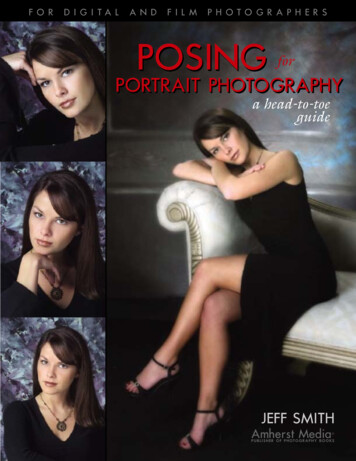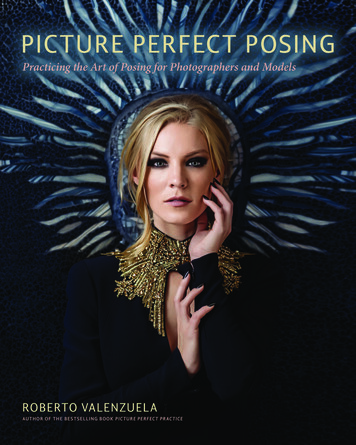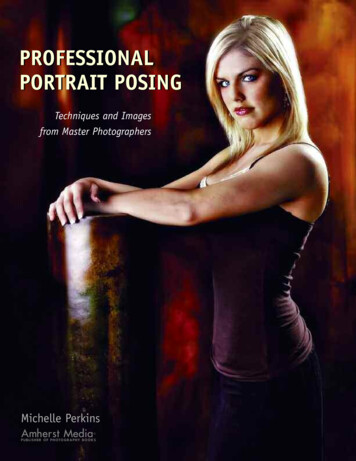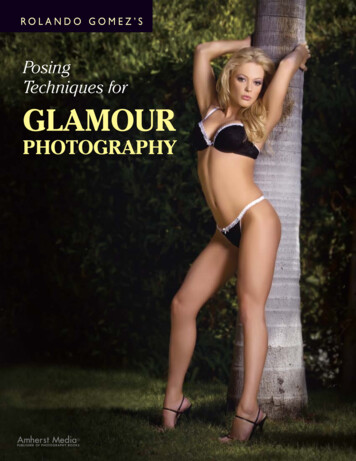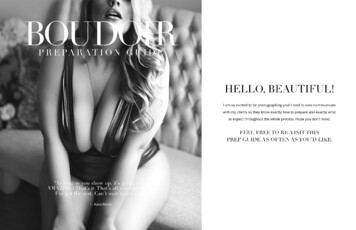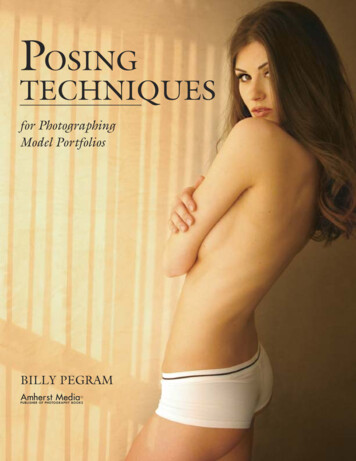
Transcription
POSINGTECHNIQUESfor PhotographingModel PortfoliosBILLY PEGRAMAmherst Media PUBLISHER OF PHOTOGRAPHY BOOKS
DedicationI would like to extend my appreciation to Dorothy Pegram, and Tom and Dolly Branski for their encouragement, love, and support in helping make this a rewarding career.Additional thanks to Loa Anderson for her special consultation, especially in sections dealing with the CSIprogram. I would also like to thank all the demo models: Bethany, Ciana, Iana, Janeen, Kasia, Krissy, Lexie, Lisa,Marisa, Mary, Monique, and Shayn.Special thanks to: Bikini Bay Sportswear and Swimwear designer Bo of Toronto, Canada; Lana Fuchs fromIsis Couture, who provided many of the fashions in the images; hair and fashion stylist Michael Hall of Seattle; hair and makeup specialist Wendalynn Nelson of Las Vegas; and makeup artists Nicci Kelly and ChristinaCopeland.Finally, thanks to: Cinch Jeans, Dusk magazine, Headlights and Tailpipes in Las Vegas, Luxury Las Vegasmagazine, and Showbiz magazine.Copyright 2008 by Billy Pegram.All photographs by the author.All rights reserved.Published by:Amherst Media, Inc.P.O. Box 586Buffalo, N.Y. 14226Fax: 716-874-4508www.AmherstMedia.comPublisher: Craig AlesseSenior Editor/Production Manager: Michelle PerkinsAssistant Editor: Barbara A. Lynch-JohntEditorial Assistance: John S. Loder, Carey A. Maines, and Artie VanderpoolISBN-13: 978-1-58428-220-4Library of Congress Control Number: 2007926868Printed in Korea.10 9 8 7 6 5 4 3 2 1No part of this publication may be reproduced, stored, or transmitted in any form or by any means, electronic, mechanical, photocopied, recorded or otherwise, without prior written consent from the publisher.Notice of Disclaimer: The information contained in this book is based on the author’s experience and opinions. Theauthor and publisher will not be held liable for the use or misuse of the information in this book.
Table of ContentsIntroduction . . . . . . . . . . . . . . . . . . . . . . . . .6The Importance of Good Posing . . . . . . . . . . . . .6Helping the Model Look Her Best . . . . . . . . .6Pleasing the Client . . . . . . . . . . . . . . . . . . . . .6The Challenges of Model Photography . . . . . . . .9Technical Challenges . . . . . . . . . . . . . . . . . .10Styling . . . . . . . . . . . . . . . . . . . . . . . . . . . . .10Working with People . . . . . . . . . . . . . . . . . .12About This Book . . . . . . . . . . . . . . . . . . . . . . .131. Basic Principles . . . . . . . . . . . . . . . . . . .14Previsualization . . . . . . . . . . . . . . . . . . . . . . . . .14Emulate the Success of Others . . . . . . . . . . .14Use Your Imagination . . . . . . . . . . . . . . . . .14Communicate Your Concept . . . . . . . . . . . .15Objectives . . . . . . . . . . . . . . . . . . . . . . . . . . . . .17Creating Flow . . . . . . . . . . . . . . . . . . . . . . .17Stopping the Gaze . . . . . . . . . . . . . . . . . . . .18Tools . . . . . . . . . . . . . . . . . . . . . . . . . . . . . . . .20Straight Lines . . . . . . . . . . . . . . . . . . . . . . . .21Curves . . . . . . . . . . . . . . . . . . . . . . . . . . . . .21Composition and Cropping . . . . . . . . . . . . .24Perspective . . . . . . . . . . . . . . . . . . . . . . . . . .27Tone and Color . . . . . . . . . . . . . . . . . . . . . .28Posing . . . . . . . . . . . . . . . . . . . . . . . . . . . . .312. Posing the Body . . . . . . . . . . . . . . . . . . .33Three Basic Rules . . . . . . . . . . . . . . . . . . . . . . .33Posture . . . . . . . . . . . . . . . . . . . . . . . . . . . . . . .33TABLE OF CONTENTS 3
CSI Program: A Starting Point . . . . . . . . . . . . .34History and Purpose . . . . . . . . . . . . . . . . . . .34Diagramming a Pose . . . . . . . . . . . . . . . . . .35The C, S, and I Poses . . . . . . . . . . . . . . . . . .35Foot Positions . . . . . . . . . . . . . . . . . . . . . . .36The Crossover and Open Poses . . . . . . . . . .36Feet and Ankles . . . . . . . . . . . . . . . . . . . . . . . . .38Show One Heel . . . . . . . . . . . . . . . . . . . . . .38Cropping . . . . . . . . . . . . . . . . . . . . . . . . . . .39Point the Toes . . . . . . . . . . . . . . . . . . . . . . .40Hide the Bottoms of the Feet . . . . . . . . . . . .42Slimming and Lengthening the Legs . . . . . .42Help for Beginning Models . . . . . . . . . . . . .44Hips and Derriere . . . . . . . . . . . . . . . . . . . . . . .44Rear View . . . . . . . . . . . . . . . . . . . . . . . . . .44Seated Poses . . . . . . . . . . . . . . . . . . . . . . . . .45Raise One Foot . . . . . . . . . . . . . . . . . . . . . .45Hands and Wrists . . . . . . . . . . . . . . . . . . . . . . .45Importance of the Hands . . . . . . . . . . . . . . .45“Bad” Hands . . . . . . . . . . . . . . . . . . . . . . . .47General Guidelines . . . . . . . . . . . . . . . . . . . .47Relaxed Positions . . . . . . . . . . . . . . . . . . . . .48Hands with Props and Products . . . . . . . . . .49Hands Around the Face . . . . . . . . . . . . . . . .51Hands at the Waist . . . . . . . . . . . . . . . . . . . .52Hands in the Waistband/Belt . . . . . . . . . . . .54Hands in Pockets . . . . . . . . . . . . . . . . . . . . .56Hands with Lapels and Zippers . . . . . . . . . . .57Hands on Thighs . . . . . . . . . . . . . . . . . . . . .59Hands in the Lap . . . . . . . . . . . . . . . . . . . . .61Practical Examples . . . . . . . . . . . . . . . . . . . .62Arms and Shoulders . . . . . . . . . . . . . . . . . . . . .67Separation from the Body . . . . . . . . . . . . . . .67Elbows . . . . . . . . . . . . . . . . . . . . . . . . . . . . .67Framing the Face . . . . . . . . . . . . . . . . . . . . .68Arms Raised . . . . . . . . . . . . . . . . . . . . . . . . .684 POSING TECHNIQUES FOR PHOTOGRAPHING MODEL PORTFOLIOS
3. Posing the Head and Face . . . . . . . . .69Views of the Face . . . . . . . . . . . . . . . . . . . . . . .69Full Face . . . . . . . . . . . . . . . . . . . . . . . . . . .69Three-Quarter View . . . . . . . . . . . . . . . . . . .69Profile . . . . . . . . . . . . . . . . . . . . . . . . . . . . .71Tilting the Head . . . . . . . . . . . . . . . . . . . . . . . .71Eyes . . . . . . . . . . . . . . . . . . . . . . . . . . . . . . . . .72Lips . . . . . . . . . . . . . . . . . . . . . . . . . . . . . . . . .76Expression . . . . . . . . . . . . . . . . . . . . . . . . . . . .80Background Selection . . . . . . . . . . . . . . . . . . .120Clothing . . . . . . . . . . . . . . . . . . . . . . . . . . . . .120Lighting . . . . . . . . . . . . . . . . . . . . . . . . . . . . .121Creating a Portfolio . . . . . . . . . . . . . . . . . . . .122Opening and Closing Shots . . . . . . . . . . . .122Arranging the Interior Images . . . . . . . . . .122Grouping . . . . . . . . . . . . . . . . . . . . . . . . . .122Stuffing . . . . . . . . . . . . . . . . . . . . . . . . . . .122Blank Pages . . . . . . . . . . . . . . . . . . . . . . . .122Variety . . . . . . . . . . . . . . . . . . . . . . . . . . . . . .1234. Posing for Different Genres . . . . . . . .81Determining the Best Market . . . . . . . . . . . . . .81Age . . . . . . . . . . . . . . . . . . . . . . . . . . . . . . .81Height . . . . . . . . . . . . . . . . . . . . . . . . . . . . .82Overall Appearance . . . . . . . . . . . . . . . . . . . .82Commercial . . . . . . . . . . . . . . . . . . . . . . . . . . .83Fashion . . . . . . . . . . . . . . . . . . . . . . . . . . . . . . .86Glamour . . . . . . . . . . . . . . . . . . . . . . . . . . . . . .86Lingerie . . . . . . . . . . . . . . . . . . . . . . . . . . . . . .90Plus-Size Models . . . . . . . . . . . . . . . . . . . . . . . .90Editorial . . . . . . . . . . . . . . . . . . . . . . . . . . . . . .93Athletic/Sports . . . . . . . . . . . . . . . . . . . . . . . . .94Catalog . . . . . . . . . . . . . . . . . . . . . . . . . . . . . . .96Swimwear . . . . . . . . . . . . . . . . . . . . . . . . . . . . .97Special Attributes . . . . . . . . . . . . . . . . . . . . . .100In Closing . . . . . . . . . . . . . . . . . . . . . . . . . . . .124Index . . . . . . . . . . . . . . . . . . . . . . . . . . . . . . .1255. Practical Examples . . . . . . . . . . . . . . . .101Bethany: Body Shot . . . . . . . . . . . . . . . . . . . .101Ciana: Symmetry . . . . . . . . . . . . . . . . . . . . . . .103Janeen: Natural Curves . . . . . . . . . . . . . . . . . .106Lexie: Showing Personality . . . . . . . . . . . . . . .109Monique: Girly, Cute, and Fun . . . . . . . . . . . .1106. Hints and Tips . . . . . . . . . . . . . . . . . . .112Build a Sample Portfolio . . . . . . . . . . . . . . . . .113Quality . . . . . . . . . . . . . . . . . . . . . . . . . . . . . .115Inform the Model . . . . . . . . . . . . . . . . . . . . . .115Begin with Portraiture . . . . . . . . . . . . . . . . . .116Create a Mood . . . . . . . . . . . . . . . . . . . . . . . .118The Model’s Comfort . . . . . . . . . . . . . . . . . . .118TABLE OF CONTENTS 5
IntroductionTHE IMPORTANCE OF GOOD POSINGOver the years, I’ve realized that there is indeed an art to posing models—an art thatall photographers, in order to be successful,must study and develop.Helping the Model Look Her Best.Beginning models in particular rely on theexperience of the photographer to guidethem to flattering poses. Even experiencedmodels, although they usually develop arather extensive repertoire of poses andmove gracefully through a series, still needthe photographer to fine-tune their poses,emphasizing their best features while minimizing the weaker ones.Often, a nervous model will simply standin front of the camera, waiting to be toldwhat to do. If you are an inexperiencedphotographer, it can be difficult to directthe model—especially since photographerstend to be better at visualizing a pose thancommunicating it clearly to a subject.Pleasing the Client. With model photography, there is an additional consideration: the client. This may be a commercialclient or, when shooting for a model’s portfolio, all of her prospective employers.There is an art to posing models, and the only way to master it is throughstudy and practice.6 POSING TECHNIQUES FOR PHOTOGRAPHING MODEL PORTFOLIOS
Getting a great model shot is not a matter ofluck—it requires patience, skill, knowledge,and commitment.If the image is being created for a commercial client, the model isoften secondary to the product; she is used solely to enhance themood of the photograph. In this case, the model’s pose must forcethe viewer’s eyes to the product or service being promoted. If a modelcan do this, while still creating an emotional response, then the photograph will be successful for the client or advertiser. Ask yourself:What are we trying to show? Is it a particular item of clothing, something special about the clothing (e.g., a zipper, material, or a design)?What is it that will prompt the viewer of the photo to want to purchasethis product?If the image is being created for the model’s portfolio, it must bedesigned to appeal to the kinds of clients from whom she is hoping togain employment. These may include designers, magazines, productmanufacturers, jewelers, and any other industry where models are employed. In addition, the images must showcase the model’s best attributes, conceal any problem areas, and appeal to her own aestheticsensibilities and personality. Again, ask yourself some questions: Whatare we trying to show? What will inspire the client to hire this model?INTRODUCTION 7
In a commercialimage, you need todetermine what willprompt the viewer ofthe photos to wantto purchase the featured product.
In a model’s portfolio, you want the potential client to see something that he can relate to and want to hire her. Variety, as seenin these three images of Ciana, is a key factor in achieving this goal.The purpose of creating the model’s portfolio is to show a widerange of looks and to feature her best attributes. Ultimately, you wantthe potential client to see something in her book that he can relate toand, based on that, want to hire her.THE CHALLENGES OF MODEL PHOTOGRAPHYAs you can imagine, all of this means that getting a great model shotis definitely not a matter of luck. One simply doesn’t happen across theINTRODUCTION 9
Successful model photography requires amastery of all the technical aspects of photography, including digital enhancements.perfect model in the perfect position with the perfect lighting andgrab a camera. Creating that flawless, captivating photograph requirespatience, skill, knowledge, and commitment. It also requires masteryof all of the other aspects of professional photography.Technical Changes. No matter how experienced you are as a photographer, there are always new techniques to learn—new equipment,new film and capture methods, and new styles. Your repertoire oftechniques must always be changing and suited to the current tastesof the market. This is especially true in the digital age, where technology grows by leaps and bounds with each passing day.Styling. An additional challenge in working in model photography is that you need to be well versed in all aspects of hair, makeup,and photo styling. Building a team of specialists is crucial in attainingprofessional status as a shooter. After you decide what you need toemphasize in the photograph, your team (makeup artist, hairdresser,10 POSING TECHNIQUES FOR PHOTOGRAPHING MODEL PORTFOLIOSFACING PAGE–Once you’ve decided on the lookyou want, having a team of specialists inplace can help you to achieve your goal.
Fashion photography is not just about recording an image, it’s about making a creative statement.Be patient during theshoot and provide plentyof positive reinforcement.and photo stylist) will all need to work together to create the optimalimage. Having specialists assist you drastically reduces your workloadand adds to the creative process. A good support team that works together frequently can even help an advanced amateur photographerbegin to produce top-quality professional work.Working with People
tingand raphrequires patience,skill,knowledge,andcommitment .
